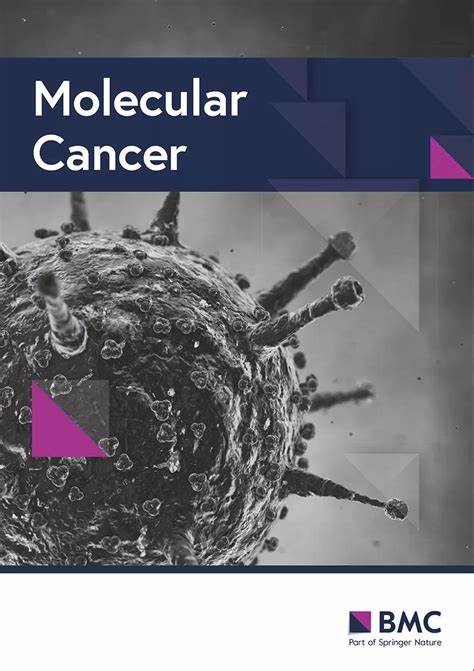Developmental interplay between transcriptional alterations and a targetable cytokine signaling dependency in pediatric ETO2::GLIS2 leukemia.
IF 33.9
1区 医学
Q1 BIOCHEMISTRY & MOLECULAR BIOLOGY
引用次数: 0
Abstract
BACKGROUND Several fusion oncogenes showing a higher incidence in pediatric acute myeloid leukemia (AML) are associated with heterogeneous megakaryoblastic and other myeloid features. Here we addressed how developmental mechanisms influence human leukemogenesis by ETO2::GLIS2, associated with dismal prognosis. METHODS We created novel ETO2::GLIS2 models of leukemogenesis through lentiviral transduction and CRISPR-Cas9 gene editing of human fetal and post-natal hematopoietic stem/progenitor cells (HSPCs), performed in-depth characterization of ETO2::GLIS2 transformed cells through multiple omics and compared them to patient samples. This led to a preclinical assay using patient-derived-xenograft models to test a combination of two clinically-relevant molecules. RESULTS We showed that ETO2::GLIS2 expression in primary human fetal CD34+ hematopoietic cells led to more efficient in vivo leukemia development than expression in post-natal cells. Moreover, cord blood-derived leukemogenesis has a major dependency on the presence of human cytokines, including IL3 and SCF. Single cell transcriptomes revealed that this cytokine environment controlled two ETO2::GLIS2-transformed states that were also observed in primary patient cells. Importantly, this cytokine sensitivity may be therapeutically-exploited as combined MEK and BCL2 inhibition showed higher efficiency than individual molecules to reduce leukemia progression in vivo. CONCLUSIONS Our study uncovers an interplay between the cytokine milieu and transcriptional programs that extends a developmental window of permissiveness to transformation by the ETO2::GLIS2 AML fusion oncogene, controls the intratumoral cellular heterogeneity, and offers a ground-breaking therapeutical opportunity by a targeted combination strategy.小儿 ETO2::GLIS2 白血病中转录改变与可靶向细胞因子信号依赖性之间的发育相互作用。
背景在小儿急性髓细胞白血病(AML)中发病率较高的几种融合癌基因与异质性巨核细胞和其他髓细胞特征有关。方法:我们通过慢病毒转导和 CRISPR-Cas9 基因编辑人胎儿和出生后造血干/祖细胞(HSPCs),创建了新型 ETO2::GLIS2 白血病发生模型,通过多种全息图像对 ETO2::GLIS2 转化细胞进行了深入表征,并与患者样本进行了比较。结果我们发现,与在出生后细胞中表达相比,在原代人类胎儿 CD34+ 造血细胞中表达 ETO2::GLIS2 能更有效地导致体内白血病的发生。此外,脐带血白血病的发生主要依赖于人类细胞因子的存在,包括 IL3 和 SCF。单细胞转录组显示,这种细胞因子环境控制了两种ETO2::GLIS2转化状态,在原代患者细胞中也观察到了这两种状态。重要的是,这种细胞因子敏感性可用于治疗,因为联合抑制 MEK 和 BCL2 比单个分子更有效地减少体内白血病的进展。结论我们的研究揭示了细胞因子环境与转录程序之间的相互作用,这种相互作用延长了ETO2::GLIS2急性髓细胞性白血病融合癌转化的发育窗口期,控制了瘤内细胞的异质性,并通过靶向组合策略提供了突破性的治疗机会。
本文章由计算机程序翻译,如有差异,请以英文原文为准。
求助全文
约1分钟内获得全文
求助全文
来源期刊

Molecular Cancer
医学-生化与分子生物学
CiteScore
54.90
自引率
2.70%
发文量
224
审稿时长
2 months
期刊介绍:
Molecular Cancer is a platform that encourages the exchange of ideas and discoveries in the field of cancer research, particularly focusing on the molecular aspects. Our goal is to facilitate discussions and provide insights into various areas of cancer and related biomedical science. We welcome articles from basic, translational, and clinical research that contribute to the advancement of understanding, prevention, diagnosis, and treatment of cancer.
The scope of topics covered in Molecular Cancer is diverse and inclusive. These include, but are not limited to, cell and tumor biology, angiogenesis, utilizing animal models, understanding metastasis, exploring cancer antigens and the immune response, investigating cellular signaling and molecular biology, examining epidemiology, genetic and molecular profiling of cancer, identifying molecular targets, studying cancer stem cells, exploring DNA damage and repair mechanisms, analyzing cell cycle regulation, investigating apoptosis, exploring molecular virology, and evaluating vaccine and antibody-based cancer therapies.
Molecular Cancer serves as an important platform for sharing exciting discoveries in cancer-related research. It offers an unparalleled opportunity to communicate information to both specialists and the general public. The online presence of Molecular Cancer enables immediate publication of accepted articles and facilitates the presentation of large datasets and supplementary information. This ensures that new research is efficiently and rapidly disseminated to the scientific community.
 求助内容:
求助内容: 应助结果提醒方式:
应助结果提醒方式:


